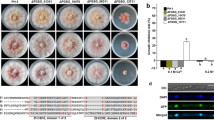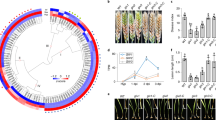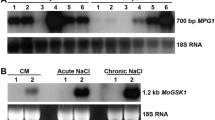Abstract.
To date, only very little is known about the molecular infection mechanisms of the head-blight pathogen of wheat, Fusarium graminearum (teleomorph Gibberella zeae). Here, we report on the isolation and characterization of the Fus3/Pmk1 mitogen-activated protein kinase homologue Gpmk1 from F. graminearum. Disruption of the gpmk1 gene in F. graminearum results in mutants that are reduced in conidial production, are sexually sterile and are fully apathogenic. This leads to the conclusion that gpmk1 is responsible for signal transduction processes taking place during the most important developmental stages in the life cycle of this fungal pathogen. Thus, Δgpmk1 mutants are a useful tool to find other important genes involved in plant-infection mechanisms. Previously, only the trichothecene biosynthesis pathway was identified as a virulence factor in F. graminearum. Hence, Gpmk1 is now the second pathogenicity trait to be known in this important plant pathogen.







Similar content being viewed by others
References
Adams JF (1921) Observations on wheat scab in Pennsylvania and its pathological history. Phytopathology 11:115–124
Bai G-H, Desjardins AE, Plattner RD (2001) Deoxynivalenol-nonproducing Fusarium graminearum causes initial infection, but does not cause disease spread in wheat spikes. Mycopathologia 153:91–98
Bowden RL, Leslie JF (1999) Sexual recombination in Gibberella zeae. Phytopathology 89:182–188
Desjardins AE, Proctor RH, Bai G, McCormick SP, Shaner G, Buechley G, Hohn TM (1996) Reduced virulence of trichothecenes antibiotic-nonproducing mutants of Gibberella zeae in wheat field tests. Mol Plant-Microbe Interact 9:775–781
Dickmann MB, Yarden O (1999) Serine/threonine protein kinases and phosphatases in filamentous fungi. Fungal Genet Biol 26:99–117
Di Pietro A, García-Maceira FI, Méglecz E, Roncero MIG (2001) A MAP kinase of the vascular wilt fungus Fusarium oxysporum is essential for root penetration and pathogenesis. Mol Microbiol 39:1140–1152
Dubin HJ, Gilchrist L, Reeves J, McNab A (1997) Fusarium head scab: global status and prospects. CIMMYT, Mexico, D.F.
Hanks SK, Quinn AM (1991) Protein kinase catalytic domain sequence database: identification of conserved features of primary structure and classification of family members. Methods Enzymol 200:38–62
Hunter T (1995) Protein kinases and phosphatases: the ying and yang of protein phosphorylation and signalling. Cell 80:225–248
Klittich CJR, Leslie JF (1988) Nitrate reduction mutants of Fusarium moniliforme (Giberella fujikuroi). Genetics 118:417–423
Kültz D (1998) Phylogenetic and functional classification of mitogen- and stress-activated protein kinases. J Mol Evol 46:571–588
Leach J, Lang BR, Yoder OC (1982) Methods for selection of mutants and in vitro culture of Cochliobolus heterostrophus. J Gen Microbiol 128:1719–1729
Lev S, Sharon A, Hadar R, Ma H, Horwitz BA (1999) A mitogen-activated protein kinase of the corn leaf pathogen Cochliobolus heterostrophus is involved in conidiation, appressorium formation and pathogenicity: diverse roles for mitogen-activated protein kinase homologs in foliar pathogens. Proc Natl Acad Sci USA 96:13541–13547
Lui Y-G, Whittier RF (1995) Thermal asymmetric interlaced PCR: automatable amplification and sequencing of insert end fragments from YAC clones for chromosome walking. Genomics 25:674–681
Madhani HD, Galitski T, Lander ES, Fink GR (1999) Effectors of a developmental mitogen-activated protein kinase cascade revealed by expression signatures of signaling mutants. Proc Natl Acad Sci USA 96:12530–12535
Mayorga ME, Gold SE (1999). A MAP kinase encoded by the ubc3 gene of Ustilago maydis is required for filamentous growth and full virulence. Mol Microbiol 34:485–497
McMullen MP, Jones R, Gallenberg D (1997) Scab of wheat and barley: a re-emerging disease of devastating impact. Plant Dis 81:1340–1348
Mey G, Oeser B, Lebrun MH, Tudzynski P (2002) The biotrophic, non-appressorium-forming grass pathogen Claviceps purpurea needs a Fus3/Pmk1 homologous mitogen activated protein kinase for colonization of rye ovarian tissue. Mol Plant-Microbe Interact 15:303–312
Müller P, Aichinger C, Feldbrügge M, Kahmann R (1999) The MAP kinase Kpp2 regulates mating and pathogenic development in Ustilago maydis. Mol Microbiol 34:1007–1017
Nirenberg H (1981) A simplified method for identifying Fusarium spp occurring on wheat. Can J Bot 59:1599–1609
Nishida E, Gotoh Y (1993) The Map kinase cascade is essential for diverse signal transduction pathways. Trends Biochem Sci 18:128–131
Ochman H, Gerber AS, Hartl DL (1988) Genetic applications of an inverse polymerase chain reaction. Genetics 120:621–623
Oeser B, Heidrich PM, Tudzynski P, Tenberge KB (2002) Polygalacturonase is a pathogenicity factor in the Claviceps purpurea/rye interaction. Fungal Genet Biol 36:176–186
Pritsch C, Muehlbauer GJ, Bushnell WR, Somers DA, Vance CP (2000) Fungal development and induction of defence response genes during early infection of wheat spikes by Fusarium graminearum. Mol Plant-Microbe Interact 13:159–169
Pritsch C, Vance CP, Bushnell WR, Somers DA, Hohn TM, Muehlbauer GJ (2001) Systemic expression of defence response genes in wheat spikes as a response to Fusarium graminearum infection. Physiol Mol Plant Pathol 58:1–12
Proctor RH, Hohn TM, McCormick SP (1995) Reduced virulence of Gibberella zeae caused by disruption of a trichothecene toxin biosynthetic gene. Mol Plant-Microbe Interact 8:593–601
Punt PJ, Oliver RP, Dingemanse MA, Pouwels PH, Van den Hondel CAMJJ (1987) Transformation of Aspergillus based on the hygromycin B resistance marker from Escherichia coli. Gene 56:117–124
Raper KB, Thorn C (1949) A manual of the Penicillia. Waverly Press, Baltimore
Royer JC, Moyer DL, Reiwitch SG, Madden MS, Bech Jensen E, Brown SH, Yonker CC, Johnstone JA, Golightly EJ, Yoder WT, Shuster JR (1995) Fusarium graminearum A 3/5 as a novel host for heterologous protein production. Biotechnology 13:1479–1483
Ruiz-Roldán MC, Maier FJ, Schäfer W (2001) PTK1, a mitogen-activated-protein kinase gene, is required for conidiation, appressorium formation, and pathogenicity of Pyrenophora teres on barley. Mol Plant-Microbe Interact 14:116–125
Sambrook J, Fritsch EF, Maniatis T (1989) Molecular cloning: a laboratory manual, 2nd edn. Cold Spring Harbor Laboratory Press, Cold Spring Harbor, N.Y.
Sanger F, Nicklen S, Coulsen AR (1977) DNA sequencing with chain terminating inhibitors. Proc Natl Acad Sci USA 74:5463–5467
Schaeffer HJ, Weber MJ (1999) Mitogen-activated protein kinases: specific messages from ubiquitous messengers. Mol Cell Biol 19:2435–2444
Schäfer W (1994) Molecular mechanisms of fungal pathogenicity to plants. Annu Rev Phytopathol 32:461–477
Schroeder HW, Christensen JJ (1963) Factors affecting resistance of wheat scab caused by Gibberella zeae. Phytopathology 53:831–838
Sutton JC (1982) Epidemiology of wheat head blight and maize ear rot caused by Fusarium graminearum. Trans Br Mycol Soc 70:187–192
Takano Y, Kikuchi T, Kubo Y, Hamer JE, Mise K, Furusawa I (2000) The Colletotrichum langenarium MAP kinase gene CMK1 regulates diverse aspects of fungal pathogenesis. Mol Plant-Microbe Interact 13:374–383
Talbot NJ, Ebbole DJ, Hamer JE (1993) Identification and characterization of Mpg1, a gene involved in pathogenicity from the rice blast fungus Magnaporthe grisea. Plant Cell 5:1575–1590
Talbot NJ, Kershaw MJ, Wakley GE, Vries OMH de, Wessels JGH, Hamer JE (1996) MPG1 encodes a fungal hydrophobin involved in surface interactions during infection-related development by Magnaporthe grisea. Plant Cell 8:985–999
Wessel JGH, Vries OMH de, Asgeirdottir SA, Springer J (1991) Hydrophobin genes involved in formation of aerial hyphae and fruiting bodies in Schizophyllum. Plant Cell 3:793–799
Wolf JC, Mirocha CJ (1973) Regulation of sexual reproduction in Gibberella zeae (Fusarium roseum Graminearum) by F-2 (Zearalenone). Can J Microbiol 19:725–734
Xu J-R (2000) Map kinases in fungal pathogens. Fungal Genet Biol 31:137–152
Xu J-R, Hamer JE (1996) Map kinase and cAMP signaling regulate infection structure formation and pathogenic growth in the rice blast fungus Magnaporthe grisea. Genes Dev 10:2696–2706
Xu J-R, Staiger CJ, Hamer JE (1998) Inactivation of the mitogen-activated protein kinase Mps1 from the rice blast fungus prevents penetration of host cells but allows activation of plant defense response. Proc Natl Acad Sci USA 95:12713–12718
Zheng L, Campbell M, Murphy J, Lam S, Xu J-R (2000). The BMP1 gene is essential for pathogenicity in the gray mold fungus Botrytis cinerea. Mol Plant-Microbe Interact 13:724–732
Acknowledgements.
We are grateful to K. Quester and M. Andermann for technical assistance and to B. Witt for critical reading of the manuscript. The F. graminearum strain 8/1 was generously provided by T. Miedaner of the Landessaatzuchtanstalt Hohenheim, Germany. This work was supported by the BASF Aktiengesellschaft, Crop Protection Research, Ludwigshafen, Germany.
Author information
Authors and Affiliations
Corresponding author
Additional information
Communicated by: J. Heitmann
Rights and permissions
About this article
Cite this article
Jenczmionka, N.J., Maier, F.J., Lösch, A.P. et al. Mating, conidiation and pathogenicity of Fusarium graminearum, the main causal agent of the head-blight disease of wheat, are regulated by the MAP kinase gpmk1. Curr Genet 43, 87–95 (2003). https://doi.org/10.1007/s00294-003-0379-2
Received:
Revised:
Accepted:
Published:
Issue Date:
DOI: https://doi.org/10.1007/s00294-003-0379-2




